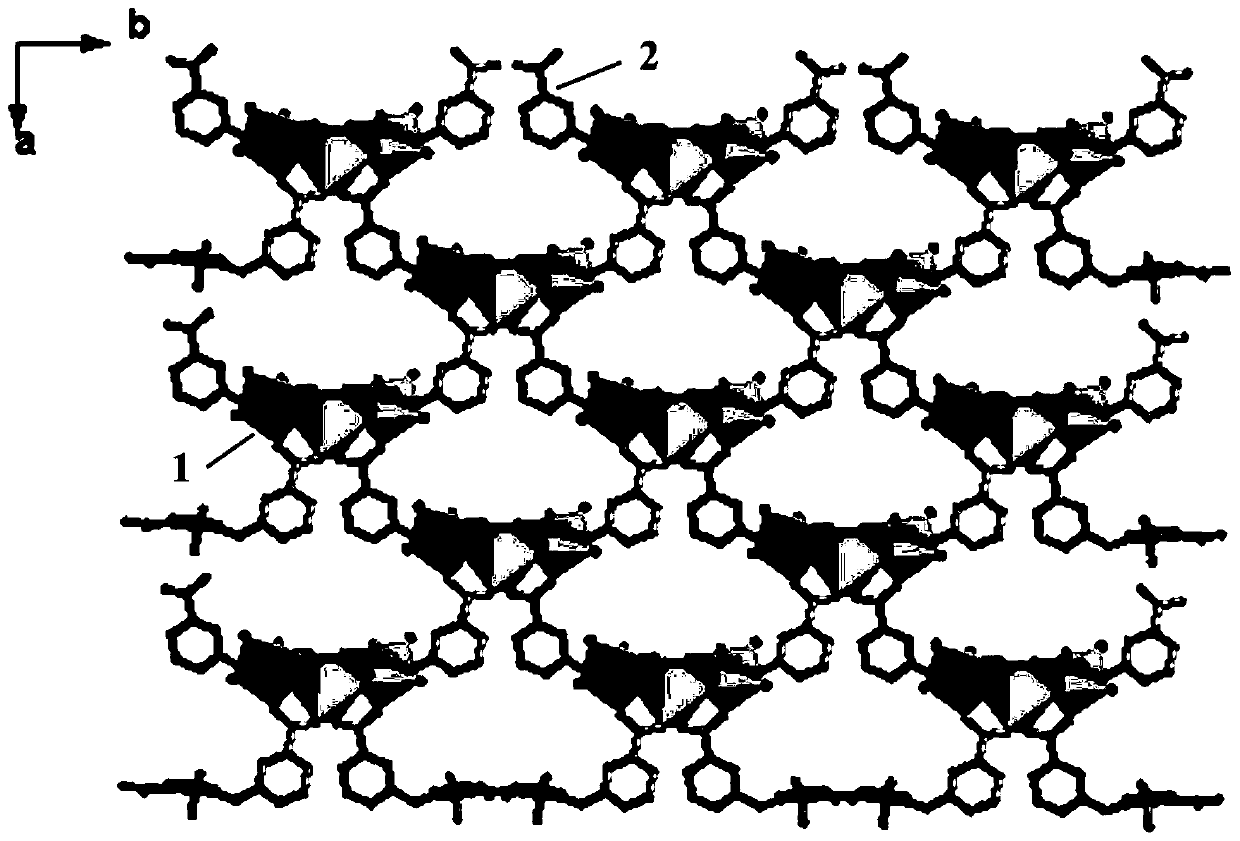A kind of chiral coordination polymer containing trinuclear cadmium cluster and its preparation method and application
A coordination polymer and chiral technology, applied in chemical instruments and methods, thermometers with physical/chemical changes, measuring devices, etc., can solve high raw material costs, less development, poor monochromaticity of thermoluminescent materials, etc. problem, to achieve the effect of pure color and stable bonding
- Summary
- Abstract
- Description
- Claims
- Application Information
AI Technical Summary
Problems solved by technology
Method used
Image
Examples
specific Embodiment approach 1
[0034] Specific embodiment one: the present embodiment is a chiral coordination polymer containing trinuclear cadmium clusters, the molecular formula of which is {[Cd 3 (C 15 h 7 o 7 ) 2 (C 10 h 8 N 2 ) 2 ]·H 2 O} n , whose structural formula is:
[0035] Wherein, the n is a positive integer; the occupancy of the O6, O7, O13, O14, O6A, O7A, O13A and O14A in the basic structural unit of the chiral coordination polymer containing trinuclear cadmium clusters is equal to is 0.5.
[0036] In this embodiment, the adjacent central metal Cd2 and Cd1 in a chiral coordination polymer containing trinuclear cadmium clusters are formed by two 3-(2',3'-dicarboxyphenoxy)benzoic acid ligands. The carboxyl oxygen atoms O2 and O11 are connected, and the adjacent central metal Cd1 and Cd2A are connected through the carboxyl oxygen atoms O3 and O9 in the two 3-(2′,3′-dicarboxyphenoxy)benzoic acid ligands connected, thus, three adjacent central metal cadmiums form a trinuclear secondar...
specific Embodiment approach 2
[0039] Embodiment 2: The difference between this embodiment and Embodiment 1 is that the basic structural unit of the chiral coordination polymer containing trinuclear cadmium clusters contains three central Cd 2+ ions, two 3-(2′,3′-dicarboxyphenoxy)benzoic acid ligands, two 2,2′-bipyridyl ligands and a free water molecule;
[0040] Among them, the three centers Cd 2+ The ions are: central metal Cd2, central metal Cd1 and central metal Cd2A; the coordination and bonding methods are as follows:
[0041] Central metal Cd2 and two oxygen atoms O1 and O2 in a 3-(2′,3′-dicarboxyphenoxy)benzoic acid ligand, another 3-(2′,3′-dicarboxyphenoxy ) two oxygen atoms O10, O11 in the benzoic acid ligand, one oxygen atom O6A in the third 3-(2′,3′-dicarboxyphenoxy) benzoic acid ligand, one 2,2′- The nitrogen atoms N1 and N2 in the bipyridyl ligand coordinate to form a bond;
[0042] The central metal Cd1 coordinates with the six oxygen atoms O2, O3, O9, O10, O7A and O14A in the four 3-(2',3...
specific Embodiment approach 3
[0045] Specific embodiment three: the difference between this embodiment and specific embodiment one or two is: the three centers Cd 2+ The ions present the seven-coordinate single-cap octahedral configuration, the six-coordinate octahedral configuration and the seven-coordinate single-cap octahedral configuration, respectively. Others are the same as those in Embodiment 1 or 2.
PUM
 Login to View More
Login to View More Abstract
Description
Claims
Application Information
 Login to View More
Login to View More - R&D
- Intellectual Property
- Life Sciences
- Materials
- Tech Scout
- Unparalleled Data Quality
- Higher Quality Content
- 60% Fewer Hallucinations
Browse by: Latest US Patents, China's latest patents, Technical Efficacy Thesaurus, Application Domain, Technology Topic, Popular Technical Reports.
© 2025 PatSnap. All rights reserved.Legal|Privacy policy|Modern Slavery Act Transparency Statement|Sitemap|About US| Contact US: help@patsnap.com



